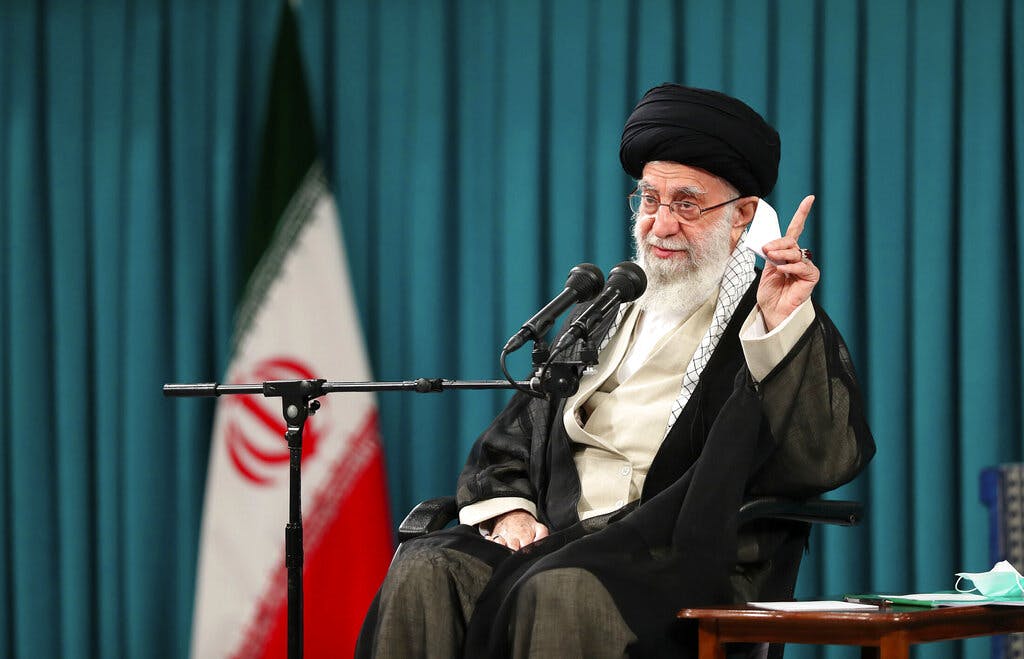Iran Is on the Brink of Revolution — or War
The three necessary ingredients for a civil war are coming together, and it might not be long before a spark sets the country on fire.

Triggered by the murder of a 22 year-old woman for wearing her hijab loosely, the streets of Iran have been occupied by young people demanding regime change. As a veteran of the 2009 protests in Iran, I stand in awe of their bravery.
Many outside Iran are wishing the protestors success and hoping for a revolution. That means that they have not learned the lessons of Syria. As long as a regime is committed to defending itself, revolutions either die or devolve into civil wars. And we have every reason to believe that the Islamic Republic will not give up power.
The capacity for violence, a will to fight, and irreconcilable political differences are the three ingredients of a civil war. Iranians are radicalized and increasingly engaging in political violence. Over the past five years, there have been three rounds of major revolts, each more violent and larger in magnitude.
Discontent is present even among the security forces, including the rank and file of the Islamic Revolutionary Guard Corps. Artesh, Iran’s regular military, is ever more prone to sympathies with the people. As political violence grows in Iran from both sides, eventually, many in the rank and file of security forces will defect. They have guns, and they are trained.
The Islamic Republic has justified the oppression of women by arguing that it is out of love to protect them, propagating decades of slogans about how women are more important than men. How many 16-year-old girls can be murdered before true believers begin to be disillusioned?
In the meantime, the black markets for guns, another blessing of social media, is a new phenomenon in a country that has an almost complete ban on the sale of weapons. Iran’s border with Iraqi Kurdistan is mountainous and can’t be policed against the smuggling of weapons.
Iran’s attacks against Iraqi Kurdistan at the beginning of the protests, killing one American, was a warning shot that the Iraqi Kurds must prevent such smuggling or suffer punishment if weapons find their way into Iran. Yet the weapons keep coming.
The three necessary ingredients for a civil war are coming together, and it might not be long before a spark sets the country on fire. The first time the regime faced an existential crisis was in 2009. I was one of the millions of protesters at the time, though I was one of the few radicals. At the time, people hoped for incremental change.
In the ten years since I have left the country, Iran has changed beyond recognition. The polity that wanted a reformist president and was appealing to religious symbolism for its political objectives has transformed into a secular society desiring regime change.
In 2009, “Ya Hossein, Mir Hossein” was the most popular chant, one that perfectly encompassed both religious and reformist themes. Ya Hossein invoked Shi’ism’s third Imam and a symbol of martyrdom, and Mir Hossein, named after the saint, was the reformist candidate. Today, only 5 percent approve of it.
A new one has replaced it: Reformist or Principalist, it’s game over. In another rejection of Islamist policies, “neither Gaza, nor Lebanon, my life is only for Iran” has become a popular protest slogan.
As demands for change have hardened, however, so too has the regime’s dedication to defend itself.
Increasingly, both sides are finding more appetite for violence against each other. The conservative elite has everything to lose. The radical, miserable population has nothing left to lose. For many young people, dying for something is becoming more appealing than living for nothing.
The root of the population’s radicalization is the wide gap between the regime’s core orthodox and imperialist values and the people’s secular and inward looking political attitudes. Imperialist policies guided by Shi’ism, as well as corruption, have caused poverty in a country rich in natural resources.
But the problem goes beyond economics. The regime and the people also disagree on moral and political questions. In 2016, Misagh Parsa, an Iranian émigré and a professor at Dartmouth University, published “Democracy in Iran.” The book’s thesis is that the values of the regime and the values of the people have diverged so far that there will never be reconciliation nor compromise between the two.
Surveys endorse this. Gamaan, a Dutch-based center that tracks public attitudes in Iran, reports that 41 percent of Iranians who responded would prefer to overthrow the regime, while 21 percent support a gradual transition into a new system. Only 26 percent would like to preserve the regime. (One suspects that most of the 11 percent non-respondents also oppose the regime but feared to express this opinion.)
Another survey by Gamaan shows that Shi’ite Islam, the regime’s creed, is a minority religion. Only 32 percent call themselves Shi’ites. On top of that, 68 percent favor a ban on any law made based on religious prescriptions, even if the religious parties control a majority in the parliament. Only 14 percent believe that religion should be the basis for law. At 1.7 per woman, the terribly low birthrate in Iran is another evidence that it is a very secular and hopeless society.
The Iranian people today are secular, repressed, and poor. Their leaders are religious, powerful, and corrupt. It doesn’t help that pictures, videos, and reports of the lavish lifestyles of the elites regularly circulate among Iranians via social media.
The opportunity for incremental reform ended with the 2010s. Because, despite a reformist administration, the removal of sanctions, and the unfreezing of Iran’s assets after the Joint Comprehensive Plan of Action, economic and political conditions worsened, while Iran’s foreign policy became more assertive. The people learned that they had never been a priority for the regime.
Sporadic protests increased in the years after the nuclear agreement until it climaxed in 2017, the most violent protests since 1979. In 2019, an even larger and more violent protest movement erupted, resulting in the murder of 1,500 Iranians in just one week.
The regime only managed to end the crisis by shutting down the Internet completely. Ever since, violence and cutting off the internet have become the regime’s go-to tricks for protest control.
Unfortunately, none of this means that regime change is in sight. In 1911, a conservative Tsarist warned of the coming revolution, saying, “as a rule, a regime perishes not because of the strength of its enemies, but because of the uselessness of its defenders.”
The Iranian regime’s defenders are far from useless. They are aware of the fate they will face if they lose power. They haven’t forgotten what happened to Muammar al-Ghadhafi. They know that a merciful death is the best they will be able to hope for if they lose power. So, they will kill as many as they must, because preserving power is synonymous with defending their lives.
With both sides more willing than ever to engage in violence, a civil war much like Syria’s is becoming likelier every day.
The regime intervened in Syria not just to save its ally but also to make a point to Iranians about how far it is willing to go to preserve its own power in Iran. They have made it clear that they would turn Iran into Syria before they lose power.
For better or for the worse, the Iranian people seem to have understood that point and taken to the streets anyways. Civil war is a risk they are willing to take.
Regime change is always a political decision made by the elite. As long as a regime’s elite refuses to give up, it will remain in power. The current elite in Iran will never opt for surrender without foreign pressure and guarantees—pressure to abdicate power, and safety guarantees once they do that. But that doesn’t mean that the regime will remain stable in the meantime.
Those who hope that protests in Iran will overthrow the regime on their own, without external assistance are fooling themselves, just as they are wrong to think of these protests as a women’s movement or about compulsory hijab.
We are witnessing a revolution. And if the American government won’t ensure that it succeeds, civil war will break out.

